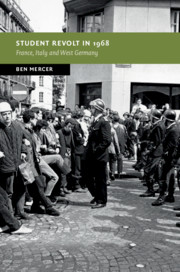Book contents
- Student Revolt in 1968
- New Studies in European History
- Student Revolt in 1968
- Copyright page
- Contents
- Acknowledgements
- Abbreviations
- Introduction: History, Myth and Memory of 1968
- Part I Education and Culture
- Part II The Politics of Revolt
- Part III Crisis of the University
- Chapter 8 ‘Question, Doubt and Criticise’
- Chapter 9 ‘Student Power’
- Chapter 10 ‘An Asylum for Delinquents’
- Chapter 11 ‘A Golden Ghetto’
- Conclusion
- Select Bibliography
- Index
Chapter 10 - ‘An Asylum for Delinquents’
The Space of Revolt at Nanterre
from Part III - Crisis of the University
Published online by Cambridge University Press: 18 November 2019
- Student Revolt in 1968
- New Studies in European History
- Student Revolt in 1968
- Copyright page
- Contents
- Acknowledgements
- Abbreviations
- Introduction: History, Myth and Memory of 1968
- Part I Education and Culture
- Part II The Politics of Revolt
- Part III Crisis of the University
- Chapter 8 ‘Question, Doubt and Criticise’
- Chapter 9 ‘Student Power’
- Chapter 10 ‘An Asylum for Delinquents’
- Chapter 11 ‘A Golden Ghetto’
- Conclusion
- Select Bibliography
- Index
Summary
Chapter 10 describes the development of student protest at the university of Nanterre. The chapter demonstrates how the politics of space, in particular the university residences, provided the basis of conflict between the administration and the protest movement. The university administration perceived the struggle as a problem of order, while the protest movement increasingly understood it through a language of autonomy and democracy. Police intervention was the most important mobilising factor, and Vietnam provided the theme through which the movement escalated. The chapter traces the creation of the vacuum of authority at Nanterre through a dynamic of provocation and repression, culminating in the birth of the 22 March Movement in the occupation of the administrative tower at Nanterre.
- Type
- Chapter
- Information
- Student Revolt in 1968France, Italy and West Germany, pp. 230 - 253Publisher: Cambridge University PressPrint publication year: 2019

